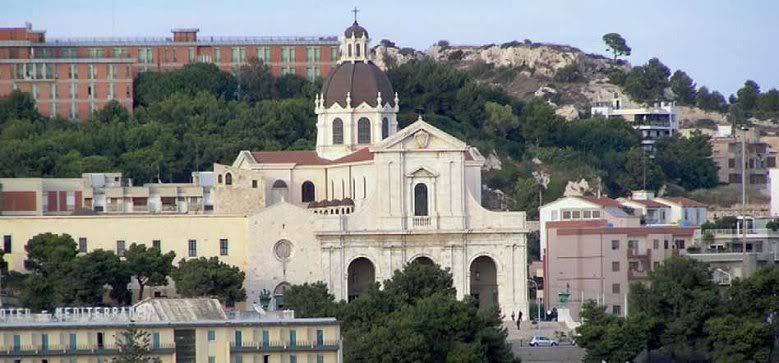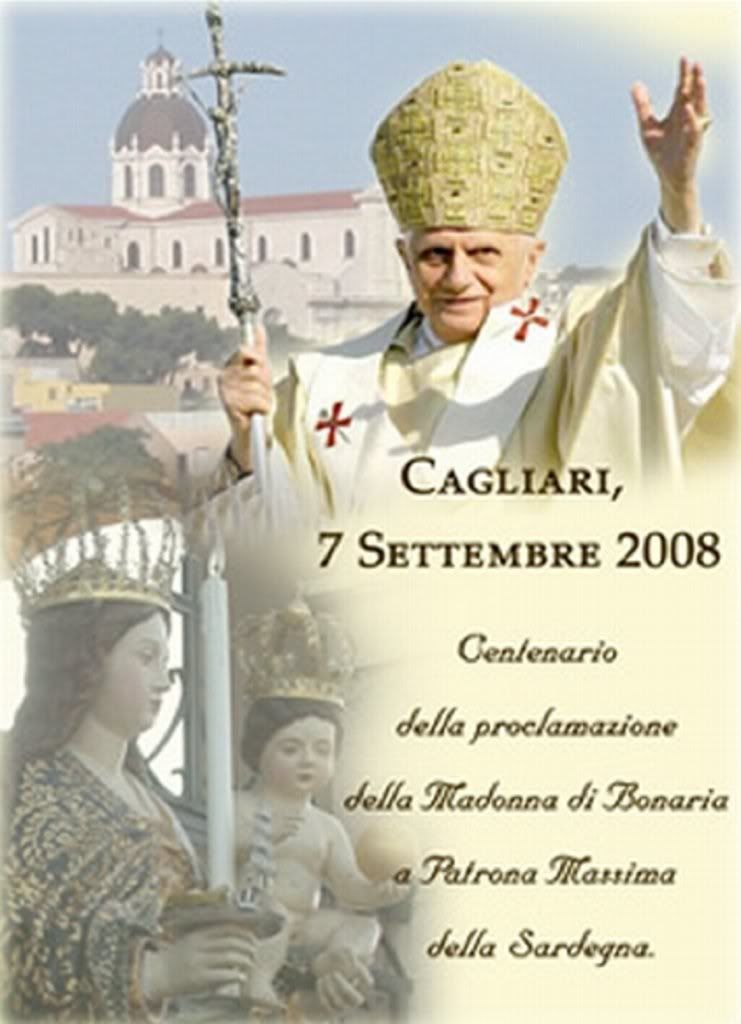
8/31/2008 3:54 AM
TERESA BENEDETTA
Post: 14,830
 The Basilica of Our Lady of Bonaria in Cagliari.
Benedict XVI's Marian destination in Sardinia:
The Basilica of Our Lady of Bonaria in Cagliari.
Benedict XVI's Marian destination in Sardinia:
Where sailors stopped to see where the wind blew
by Mario Ponzi
Translated from
the 8/31/08 issue of

The subtle Marian weft that traverses the Magisterium of Benedict XVI - underlined by Archbishop Fernando Filoni,
deputy Secretary of State, in an interview after the Pope's visit to Santa Maria di Leuca and Brindisi - will soon
be enhanced by another highlight.
As we know, on September 7, the first Sunday of the month, the Pope will go to Cagliari to venerate the image of
Our Lady of Bonaria, thus concluding the celebrations for the centenary year of the proclamation of the Virgin
as the Supreme Patroness of Sardinia.

The celebrations began in September 13, 2007, the day on which, 100 years earlier, Pope Pius X conferred the title
on the 'Lady of the Sards'.
The story of this Marian statue, which has been the focus of more than seven centuries of the anxieties, concerns
and hopes of the peoples of the sea around Sardinia, is not unlike many that have been handed down in every corner
of the earth where there is a special place in the hearts of the faithful for the Mother of God.
Rivers of words are still being gathered these years in valuable volumes - the last just off the press, edited by
the committee for the centenary of the Marian Basilica - to tell the story with an abundance of details. So there is
nothing new to add that has not already been said or written.
But what is striking is that between the lines of the different authors who have undertaken the narration -
almost all of them strictly Sard - appears a Marian devotion that is truly rooted in the soul of the Sardinian
people, to the point of constituting the vital fabric of their most profound religious sentiments.
It is worth recalling an episode, remote in time but extremely significant in this respect. In the annals of
the island, one reads that on March 7, 1632, the three orders of the Sard Parliament established in 1421 assembled
in the Cathedral of Cagliari.
On that occasion, their members, in the name of the inhabitants of the island, pledged to remain faithful to
the truth of the Immaculate Conception of Mary. And this happened exactly 222 years before the dogma of
the Immaculate Conception was proclaimed by the Church.
Even today, this Marian vein profoundly characterizes the ultra-millennial faith of the Sards. The course of time,
the daily confrontation with atavistic problems that have never been resolved, the stupefaction in the din of
a modernism which has not succeeded in undermining very ancient roots -- which, even if wounded, continue
to provide vital lymph for the new generations - have not weakened the genuineness of the affection that links
the Sards to their "Lady of the Good Air (Bonaria)".
There is not a single embarkation leaving the port of Cagliari that does not carry an image of the Madonna of Bonaria.
Perhaps they no longer carry out the old rite of coming to the shrine before taking out to sea, in order to seek
the protection of the Virgin, or to find out the direction of the wind just beyond the port according to
the indications of a mysterious little boat that hangs from the ceiling in a corner of the church. But in the heart
of every sailor, that rite replays itself every time their prow points to the open sea.
From the sea 700 years ago came the beautiful wooden sculpture, carved from a carob trunk, 156 centimeters high
(about five feet one-and-a-half inches) - which shows the Virgin holding the Infant Jesus. It was around this statue
that the shrine of Bonaria was built.
The story is interwoven with that of the Mercedari order who have been on the hill of Bonaria since the 1300s.
They were first brought there by the Sard noble Carlo Catalano who, during a mission in Spain, had occasion to know
and appreciate the work of these priests, who were pledged to ransom Christians from slavery and captivity by
gathering alms and goods in kind to buy their liberty.
In 1335, King Alfonso of Aragon gave them the chapel which he had built on the hill of Bonaria to thank God
for his victory over the Pisans, whom they now controlled from the island.
And it was due to the zeal of a historical Mercedari, Fr. Francesco Sulis, that the report has come down to us
of that event which marked the journey of faith for the island of the four Moors.
In Father Sulis's account, written in 1867, he tells of a Spanish ship headed for Italy which found itself
in the midst of a furious tempest just off the Sardinian coast. It was a boat of light tonnage and the gigantic
waves would surely have swallowed it if the captain had not ordered all the cargo tossed overboard and whatever
else was not necessary for navigation.
After the last item was thrown off - an enormous chest - the sea calmed down. To their amazement, the sailors
noted that the chest was the only object that had not sunk. They tried in vain to recover it, but the chest
started to 'navigate' by itself, drawing the ship in its wake towards shore, without anyone controlling it.
It landed at the foot of the hill of Bonaria, where in the meantime, a small crowd had gathered to watch what
was happening at sea. Then, summoned by a boy, some Mercedari priests from the nearby convent came to the shore.
For them, it was a natural thing to bring the chest in.
Only then did they notice that the emblem of their order was inscribed on the chest. They brought it to
the convent on the hill and they opened it easily. Inside, they found the statue of the Madonna. They showed it to
the crowd which had grown by now. Everyone fell to their knees. It was the first act of veneration towards
Our Lady of Bonaria.
The events that followed have since been countless - of repeated miracles and the growth of popular devotion,
of the construction of a temple increasingly more worthy of housing the image, up to the pontifical proclamation
whose centenary is being marked.
The people of the sea, in particular, have a very special devotion to Our Lady of Bonaria. This became even more
marked after, one day, in front of the main altar of the old Basilica, there appeared a small ivory boat
hanging from a cord right in front of the statue of the Madonna.
It was said to be an ex-voto [offering in fulfilment of a vow] left by an anonymous pilgrim in thanks for being
saved from a shipwreck. The boat appeared to indicate by the position of its prow the direction which the wind
was blowing beyond the port. That was how sailors started passing by the Basilica first to check wind conditions
before heading out to sea. The indication appeared to be correct all the time. No one ever saw it move, but
nonetheless it always pointed in the right direction according to where the wind was blowing.
That boat still hangs there. Does it continue to indicate the wind direction? Perhaps. What it definitely tells
is the story of a profound devotion. That of the people of the sea of Sardinia.